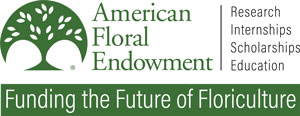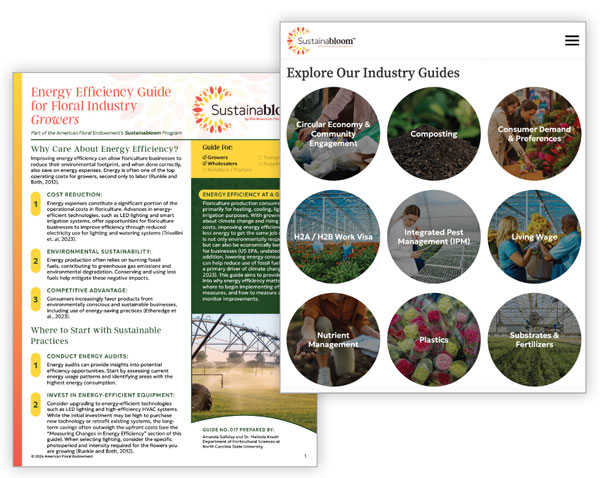3/1/2025
Energy Roadmap
Carla Dempsey

As spring brings the peak season for greenhouse production, optimizing energy efficiency becomes more important than ever. With longer days and fluctuating temperatures, growers can implement strategic changes to reduce costs and enhance sustainability. As in all sectors of business and industry, those in floriculture can see many advantages by strengthening their energy efficiency processes.
Growers and wholesalers rely on energy for operations such as heating, cooling, lighting and irrigation. Those who place a greater emphasis on sustainable energy conservation practices within those areas can see a reduction in their environmental impact, which, in turn, helps businesses more easily navigate evolving compliance regulations, ensure safer work environments for employees and establish positive reputations among clean environment communities. One of the biggest potentials is operational cost savings as it relates to energy usage, which has historically been a leading expense for growers.
Improving energy efficiency is beneficial for all members of the floriculture supply chain and it doesn’t have to be overwhelming. The American Floral Endowment (AFE) has developed a way to break down the information on energy efficiency in the industry by sharing comprehensive resources created by top researchers in the field. As part of AFE’s Sustainabloom initiative, the resources include a guide that growers and wholesalers can follow to implement greener solutions in their operations and learn more about how others in the industry approach energy efficiency. The guide is also a useful tool in helping all members of the supply chain learn more about sustainability in the industry.
Practical tips
Researchers Amanda Solliday and Dr. Melinda Knuth with the Department of Horticultural Sciences at North Carolina State University developed the guide pulling from thousands of pieces of research on the subject to create a roadmap for floriculture businesses. The researchers curated their findings to identify eight starting points for sustainable energy practices. Their tips provide ways to:
■ Conduct energy audits
■ Invest in energy-efficient equipment
■ Install a greenhouse covering
■ Optimize heating and cooling systems
■ Maximize natural lighting
■ Improve irrigation practices
■ Consider alternative energy sources
■ Educate and train employees
Backed by research and their own expertise, Amanda and Melinda offer insights and practical ways businesses can discover areas within their operations and update those methods to be more sustainable.
“Energy efficiency really hits the sweet spot for sustainability,” Amanda said. “You can help the environment while saving money and it’s easy to take the first steps.”
Outside of their business doors, owners can also learn about the innovative solutions other industries are creating to help the floriculture sectors advance in their energy goals. The guide highlights the work of a manufacturing company that’s developed a sustainable water filtration product that serves as an alternative to non-biodegradable materials that contribute to high energy consumption and usage.

Ongoing effort
Implementing some real-world practices for energy efficiency is a good first step for floriculture businesses. However, a further-reaching sustainability approach is to follow up and observe how effective those changes are.
Pictured: Growers can use the Energy Efficiency Guide to implement practical solutions that benefit both the environment and their bottom line.
In the guide, the researchers also stress the importance of tracking and monitoring energy-saving efforts. Regular monitoring can provide information about how well solutions are working and what additional implementation or changes may be needed. Businesses can best achieve this, the researchers note, by first setting goals, monitoring performance and making changes when needed. Other resources are available as part of Sustainabloom, including a guide on how to establish a carbon accounting method and other assessment tools that can help businesses further their efforts with monitoring.
In addition to information about tracking sustainability methods, the guide also provides information about ways industry members can track their return on investment from their energy consumption and usage changes and find useful links to business incentive programs and certification guidelines.
By taking steps to improve energy efficiency, growers can reduce costs, enhance sustainability and stay ahead of evolving industry regulations. AFE’s Sustainabloom initiative provides the tools and research-backed insights needed to navigate this journey. Whether starting small or making major operational shifts, growers can use the Energy Efficiency Guide to implement practical solutions that benefit both the environment and their bottom line. With continued effort and access to valuable resources, the industry can move toward a more sustainable and resilient future. GT
AFE’s commitment to advancing the floriculture industry is supported by top research analysis of sustainability best practices in all areas of the industry and ensuring that those resources are accessible to growers and all industry professionals. In addition to Sustainabloom’s resources and guides, AFE offers additional information to growers, including the Thrips and Botrytis Research Library, a monthly Grow Pro Webinar Series and quarterly Growing Further Newsletter.
Carla Dempsey is a seasoned freelance writer and editor with over 25 years of experience as a professional journalist and magazine writer. She covers the Sustainabloom initiative for the American Floral Endowment, bringing her expertise to the forefront of sustainability in the floral industry.